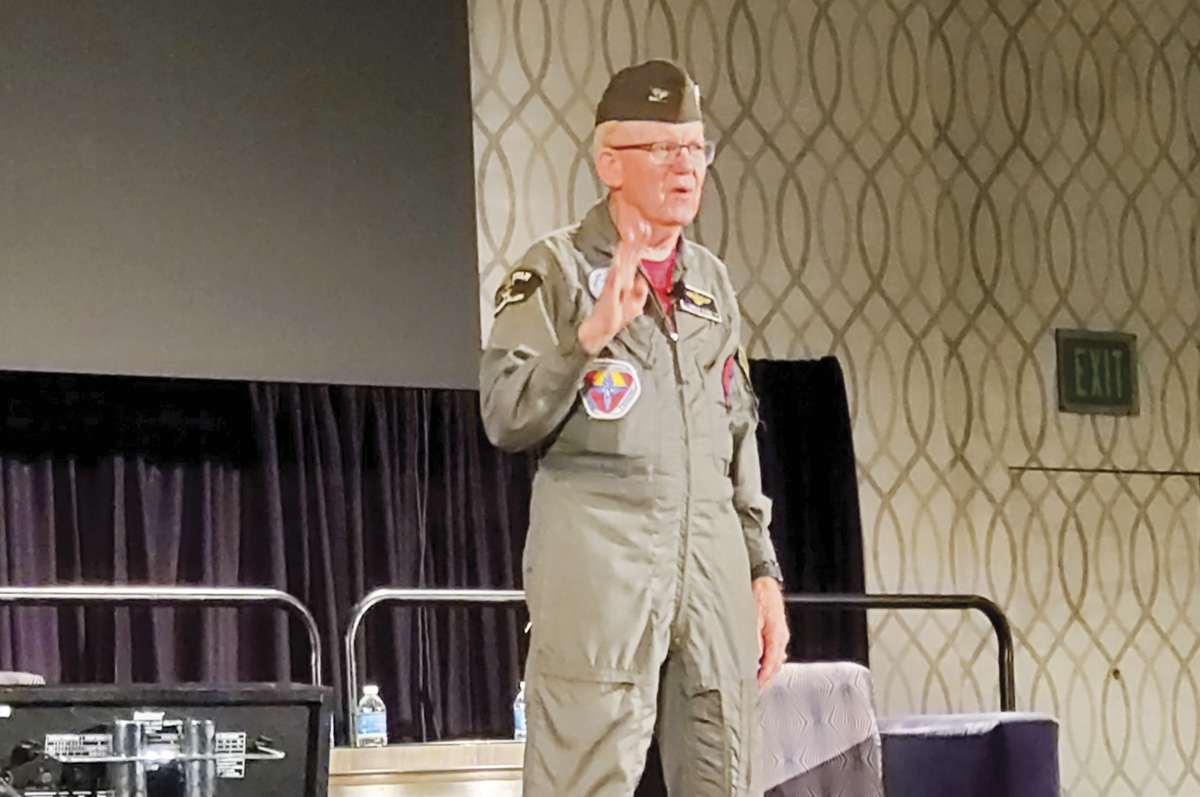Heavy snow and blizzard conditions impacted land and air travel to the Western Dairy Management Conference, Feb. 28 – March 2 in Reno, Nevada.
Yet, 835 dairy producers and industry representatives were able to attend, and thanks to today’s technology some of the speakers were able to give their presentations from remote locations.
“Despite the challenges of the weather, we had a very successful conference,” said Mike Brouk, professor and extension specialist at Kansas State University and co-chair of the conference.
It started with a jam-packed morning of 27 pre-conference presentations from the platinum sponsors and followed with plenary sessions covering on-farm topics like disease control, calf care, breeding management, feeding corn silage and milk flow, to broader industry topics such as the checkoff, farm bill and ag labor.
How is the checkoff being future ready?
From its start in 1983, when dairy farmers were producing 17 billion more pounds of milk than were being consumed, the checkoff was tasked with driving sales, innovation and new products.
Stan Erwine, S.V.P. farmer relations, Dairy Management Inc. (DMI), reported the dairy category grew by 17% over 25 years and that 2021 was a record year for dairy product consumption.
“Per-capita consumption of dairy is increasing, but we’re consuming dairy differently than we ever did,” Erwine said. “We’re providing products to consumers in places and ways they want to consume it.”
Paul Ziemnisky provided several examples of how the checkoff is working to develop dairy products around the globe.
“The goal is to look at where the consumer is going and to make sure we’re positioned to succeed with amazing products, marketing, messaging and commercialized products, both here and around the globe,” said Ziemnisky, Group E.V.P., head of health and wellness, insights and innovation at DMI.
For food service, the checkoff has encouraged restaurants like Taco Bell, Domino’s and McDonald’s to use cheese and other dairy products in current menu offerings and helped create new menu items as well.
In addition, the checkoff is working with General Mills in launching new yogurt lines for kids and adults, as well as milk smoothie stations in schools. They worked with Kroger on a line of smoothies that will be placed in the fruit section of the store and consult with Amazon on how consumers can shop for dairy online.
“Our job is to make sure dairy is front and center,” Ziemnisky said.
In return, these partners spend over $1.5 billion in advertising that promotes products containing dairy.
Further innovation will come from “using milk and milk’s molecules to their fullest potential,” Ziemnisky said.
The checkoff funds a lot of research and development in the university system and is utilizing a research database to identify new opportunities to concentrate specific molecules like lactoferrin, sphingomyelin and tryptophan to develop products around them.
In sharing the message of dairy, Anne Warden, Group E.V.P., head of marketing, communications and affairs at DMI, said they are focusing on three key areas: winning the next generation of consumers, boldly asserting dairy as sustainable nutrition, and to be an engine for the entire U.S. dairy industry to have one unified voice.
These areas are being met through several different means, such as partnering with social media influencers, appearing online where people have questions about nutrition and health, and in schools.
“We’re using new technology, digital capabilities, AI, so that we can take the investment you’re making and reach a lot more consumers and more channels,” Warden said.
‘Exports are going to be the engine of growth’
Will Loux of the U.S. Dairy Export Council encouraged milk producers to keep their eyes across the oceans toward global markets and reaffirm their long-term potential to buoy U.S. milk prices.
“We are so ingrained in the international market,” said Loux, who is VP of global economic affairs for USDEC. “We need exports to maintain current domestic market milk balance today. We are one of the biggest, if not the biggest, supplier to the global market of skim milk solids and nonfat dairy ingredients.” The U.S. has the supply of skim and whey ingredients that the world demands, he said. Currently, more than 70% of U.S. nonfat dry milk goes overseas and close to 60% of whey gets exported.
Loux said the U.S. footprint in the global dairy product marketplace in dairy protein and fat together is equal to roughly the milk production of California – the nation’s No. 1 dairy state.
“If you want to think about how much we’re moving overseas, that’s the scale we’re talking about,” Loux said.
He reported that U.S. dairy exports have been growing at a faster rate than U.S. dairy markets. He acknowledged the marketing challenge of focusing on both domestic and foreign markets.
“When things go wrong domestically, we need a strong international presence, and in the same way, if things go wrong internationally, we need a strong domestic market to lean back on.”
He projected that U.S. dairy exports can continue to grow in 2023, but not without headwinds.
“We’ve got to keep investing in this international market because we’re not going to win market share easily, nor will our competitors let us win easily,” Loux said. “But customers are looking back to the U.S., and rightly so, because I don’t think they trust New Zealand and Europe are going to be able to meet their demand needs in five years' time due to increasing water and emission regulations in those markets.”
Labor issues
With 11 million job openings in the U.S. and a national unemployment rate of 3.4%, there are more open positions than people to fill them. The situation is even worse when you look at rural areas.
Matt Clark, agriculture analyst at Terrain, reported the median unemployment rate in the nation’s top 32 dairy counties is 2.7%.
When you factor in the lower population of rural counties, Clark said, one-third of those counties have less than 1,000 people who are unemployed.
“Many of those are counties where your total unemployment population is maybe 50, 60, 100 people that you’re trying to draw on to fill your labor force,” Clark said.
“Frankly, that’s difficult, because those 50 individuals probably don’t fit in your dairy,” he added.
Rural areas also have some of the lowest ratios of working-age population to total population. He noted older populations, lower birth rates and negative net migration rates, and this doesn’t appear to be changing any time soon.
Therefore, Clark said, “Your human resource plan as a dairy is as important as your feed management plan.”
Charlie Garrison, president at The Garrison Group LLC, who has been working on labor policy in Washington D.C. for 25 years, said immigration reform is the most difficult political issue of our time.
In terms of ag labor reform, Garrison said, “We’ve gotten close several times. We need to keep working on it. Obviously, this issue is too important for this industry to pass up, and you never know when the stars might align.”
However, with the divided U.S. government, he said the current outlook for reform is weak.
In operating the only CAFO in San Diego County, California, dairy producer Frank Konyn understands his labor competition isn’t other farms, but big box stores and fast food restaurants.
“I’m competing against companies that are looking for somebody to stock a shelf, to flip a hamburger, to do menial labor, and they’re paying still a higher wage,” Konyn said.
Now with the state’s ag overtime change, he is focused on helping his employees make the most of their time on the farm.
“[An employee’s] overtime is not what he does in his ninth or tenth hour,” Konyn said, “but his overtime is what he did in his first hour that made him inefficient for the rest of the day and caused his shift to go over the eight hours.”
Konyn also finds it helpful to diversify his workforce, as it broadens the amount of people everyone might know when looking to fill the next position.
Since most dairy producers grew up managing cows and at some point transitioned to managing people, Robert Hagevoort said, “Producers are doing a great job at being employers with what they were given.”
In this tough labor market, Hagevoort, an associate professor and extension dairy specialist at New Mexico State University, suggested producers who find themselves to be stronger at handling technical issues consider hiring another individual whose strength is working with people.
“A person that is good on that HR piece is worth their weight in gold,” he said. “Bring in where you have the need, and that can be from a totally different industry.”
Empowered to win, empowered to fail
Valuing the people around you was something Capt. Charlie Plumb understood deeply while held captive for six years in an 8-by-8-foot cell.
As a Naval fighter pilot, Plumb was shot down on a mission over Vietnam, captured, tortured and imprisoned with other American prisoners of war.
“The same challenges you and I face on a daily basis are the very challenges that I faced in that prison cell,” Plumb said.

Capt. Charlie Plumb shared his survival tips from six years as a prisoner of war and how it relates to the dairy industry and life. Photo by Karen Lee.
The first person that helped Plumb in his life-changing moment was the parachute packer. Several years after returning home, Plumb met this individual in a restaurant close to where he was from. As he expressed his gratitude to the individual who had a hand in saving his life, the parachute packer told him that he didn’t know of all the individuals he saved, but said, “‘It’s enough gratification for me just to know that I’ve served.’”
Plumb related, “Isn’t that what agriculture is all about, packing parachutes, keeping folks fed and safe?”
He asked the audience to think about the people who look to them for strength and, more importantly, to think about the people who are packing your parachute and if you’ve thanked them lately.
One person who helped pack Plumb’s “parachute of life” was a basketball coach when he was a kid. He taught him life is what you chose it to be. “You can absolutely elect to step back and become the victim, or you can step forward and become the victorious. It’s your choice,” Plumb said.
At the Naval Academy, an admiral told him he could do anything he set his mind to do.
Both of those individuals imparted lessons that Plumb retained throughout his life. “They empowered me to win. They empowered me to fail. Most importantly, they empowered me to make my choice between the two,” Plumb said, adding “and so it is in the dairy business.”
Looking around the room, he drew attention to the network of people in the dairy industry today.
Plumb communicated with his network of people in the prison with the tug of a wire to a memorized code. In doing so, they were able to validate each other’s existence and help one another survive the challenges they faced.
Whether a prisoner of war or working in the dairy industry, Plumb said, “There’s value in this adversity. Challenge yourself to figure it out, and then you’ll tug on some wires. Communicate with folks, validate their existence, apply the very basics of life, and I’m convinced you can do anything you set your mind to.”








